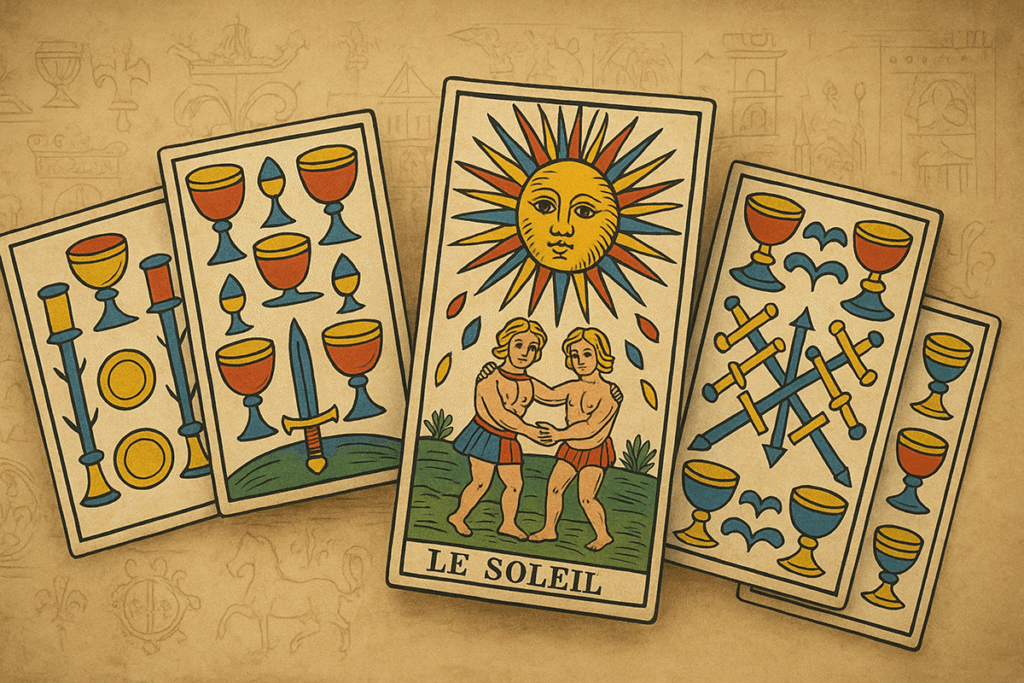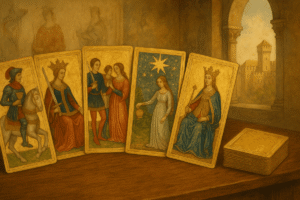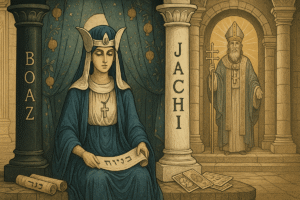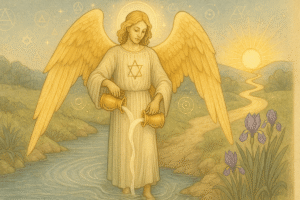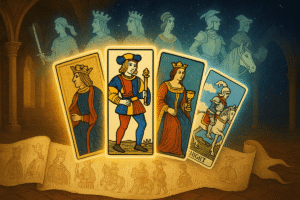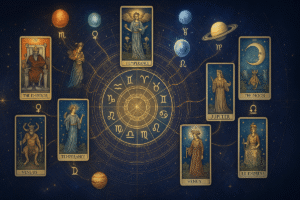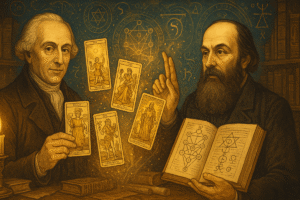Table of Contents
When I first encountered a Tarot de Marseille deck, I’ll admit I felt slightly disappointed. Where were the detailed scenes? The symbolic imagery that seemed to tell complete stories? Coming from the Rider-Waite-Smith tradition like most modern readers, those simple pip cards felt almost… empty. But perhaps that initial reaction reveals more about our expectations than the cards themselves.
The Tarot de Marseille represents something profound in the evolution of tarot. It’s not just an older deck design; it’s a window into how people approached divination and self-reflection before our modern, image-heavy culture shaped our expectations. Understanding this historical context might just transform how you think about tarot reading entirely.
The Historical Foundation of European Tarot
The Tarot de Marseille isn’t actually from Marseille, though the name suggests otherwise. This standardized pattern emerged across Europe during the 17th and 18th centuries, with various regional publishers creating decks that shared remarkably consistent imagery and structure. The “Marseille” designation came later, possibly because many surviving examples were produced in that French port city.
What strikes me most about studying these historical decks is how they reflect a completely different relationship with symbolic imagery. These weren’t mass-produced consumer products designed for easy interpretation. They were working tools, created by artisans who understood that meaning emerges from engagement, not from passive observation.
The artwork itself tells this story beautifully. The Major Arcana cards feature bold, archetypal figures rendered in a style that prioritizes symbolic clarity over artistic sophistication. The Fool carries his bundle, the Hermit holds his lantern, the Devil stands between two chained figures. These images communicate their essential meaning through gesture and composition rather than through intricate detail.
Think about what this might mean for your own tarot practice. How often do we rely on tiny symbolic details in modern decks to guide our interpretations? The Marseille tradition suggests that perhaps the most powerful symbols are also the most universal and immediate.
Understanding the Pip Card System
Here’s where the Tarot de Marseille becomes truly fascinating, at least from a historical perspective. The Minor Arcana consists entirely of what we call “pip” cards. These show only the suit symbols arranged in patterns, much like a modern playing card deck. No scenes, no human figures, no obvious narrative content.
I remember the first time I tried to read with pip cards. It felt like trying to speak a language I’d never learned. The Seven of Swords was just seven swords arranged in a pattern. No figure sneaking away with stolen blades, no castle in the background, no visual story to guide interpretation. Just seven swords and whatever meaning I could discover within that stark presentation.
This minimalist approach actually reveals something profound about the nature of symbolic thinking. Without predetermined imagery to guide us, we’re forced to engage more actively with the cards. What does seven feel like as a number? What qualities does the suit of swords embody? How do these elements combine in your particular question or situation?
The pip cards invite us to become more creative interpreters. They assume that meaning will emerge from the interaction between the reader, the cards, and the moment of inquiry. Perhaps there’s wisdom in this approach that our image-saturated modern world has forgotten.
The Art and Aesthetics of Marseille Imagery
The visual style of the Tarot de Marseille reflects the artistic sensibilities of its era, but it also serves deeper symbolic functions. The colors tend toward primary tones: bold reds, deep blues, bright yellows. The figures are rendered in a somewhat naive or folk-art style that emphasizes symbolic content over realistic representation.
This aesthetic choice wasn’t accidental or due to limited artistic skill. Medieval and Renaissance artists were perfectly capable of creating realistic imagery when that served their purpose. The stylized approach of the Marseille tradition suggests something different: these images were designed to function as symbols first, artwork second.
Looking at the Major Arcana figures, you might notice how their poses and attributes communicate meaning through archetypal gesture rather than individual characterization. The Emperor sits rigidly on his throne, embodying authority through posture. The Strength card shows a woman opening a lion’s mouth, the action itself conveying the card’s essential meaning.
This symbolic approach creates cards that work more like hieroglyphs than illustrations. They point toward universal human experiences and psychological states rather than telling specific stories. When you’re working with these images in a reading, you might find yourself accessing different layers of meaning than you would with more narrative-driven artwork.
How Marseille Influenced Modern Tarot Development
Understanding the Tarot de Marseille becomes essential when we consider how revolutionary the Rider-Waite-Smith deck really was. Arthur Edward Waite and Pamela Colman Smith weren’t just creating another deck; they were fundamentally reimagining how tarot could function as a divinatory and reflective tool.
The innovation of adding narrative scenes to all 78 cards transformed tarot from a system requiring extensive memorization and intuitive leap-making into something more immediately accessible. Suddenly, a novice reader could look at the Three of Swords and see heartbreak depicted directly in the imagery. The Ten of Pentacles showed family wealth and security through its domestic scene.
But perhaps something was also lost in this transition. The Marseille tradition required readers to develop a more personal relationship with the symbolic language of tarot. Without detailed scenes to guide interpretation, readers had to cultivate their own understanding of how numbers, suits, and archetypal energies combined to create meaning.
This historical perspective might prompt some interesting questions about your own tarot journey. Do you ever find yourself overly dependent on the specific imagery of your chosen deck? What happens when you try to read more abstractly, focusing on elemental and numerical correspondences rather than illustrated scenes?
Working with Marseille Cards in Modern Practice
If you’re considering exploring the Tarot de Marseille yourself, be prepared for a different kind of learning curve. These cards ask more of you as a reader. They assume you’ll bring your own associations, experiences, and intuitive insights to the interpretive process.
The pip cards, in particular, require you to understand tarot’s underlying structure more deeply. You’ll need to develop a feeling for what each number represents, how the four suits embody different aspects of human experience, and how these elements combine in endless variations. It’s like learning to improvise jazz after years of reading sheet music.
Many readers find that working with Marseille cards for even a short period transforms their understanding of tarot generally. The experience of reading without narrative imagery can free you from over-dependence on deck-specific symbolism. You might discover that your intuitive abilities are stronger than you realized.
The reflective nature of this older tradition also aligns beautifully with contemporary approaches to tarot that emphasize personal empowerment and self-discovery. Instead of seeking definitive answers, Marseille cards excel at prompting meaningful questions and encouraging deeper self-examination.
The Enduring Legacy of Traditional Patterns
Today’s tarot landscape offers an almost overwhelming variety of artistic styles and thematic approaches. We have decks inspired by every mythology, aesthetic movement, and cultural tradition imaginable. In this context, the stark simplicity of the Tarot de Marseille might seem almost quaint.
Yet there’s something to be said for returning occasionally to these historical roots. The Marseille tradition reminds us that effective divination doesn’t require elaborate artwork or complex symbolism. Sometimes the most profound insights emerge from the simplest prompts.
Perhaps most importantly, understanding the Tarot de Marseille helps us appreciate the full spectrum of tarot’s evolution. We can better understand both what we’ve gained and what we might have lost as the tradition developed. This historical perspective can enrich our modern practice, whatever deck we choose to work with.
The cards themselves seem to embody a different relationship with mystery and meaning. They don’t try to make everything explicit or immediately understandable. Instead, they invite us into a collaborative process of meaning-making that requires patience, creativity, and trust in our own interpretive abilities.
In our current era of instant information and detailed explanations for everything, there might be profound value in occasionally working with tools that demand more from us, that resist easy categorization, and that honor the irreducible mystery at the heart of genuine self-reflection.
Frequently Asked Questions
Is the Tarot de Marseille harder to learn than Rider Waite Smith decks?
The Marseille can feel more challenging at first because the pip cards lack illustrated scenes, requiring you to understand numerology and suit meanings more deeply. However, many readers find that once they grasp the fundamentals, the Marseille actually strengthens their intuitive reading abilities since they’re not dependent on specific imagery. Think of it as learning a new language versus learning to read picture books. It requires more initial effort, but the skills you develop are more transferable and flexible.
Can I start with just the Major Arcana when learning Tarot de Marseille?
Many experienced Marseille readers actually use only the 22 Major Arcana cards for readings, and this approach works beautifully for beginners too. The Major cards are more immediately accessible than the pip Minors and can answer questions just as thoroughly. Some readers later add pip cards on top of Major cards when they want practical implementation strategies. This gives you permission to ease into the deck gradually rather than feeling overwhelmed by all 78 cards at once.
Do the cards mean different things in Marseille versus Rider Waite Smith?
While both decks share the same basic structure of 78 cards and similar archetypal meanings, there are some numbering differences, like Strength being card 8 in Marseille but card 11 in Rider Waite Smith. For the pip cards specifically, Marseille readers typically work more with numerological principles and elemental suit meanings rather than the narrative scenes shown in illustrated decks. The core energy of each card remains similar, but the interpretive approach differs, focusing more on universal patterns than specific stories.

